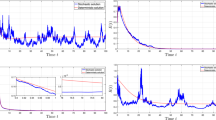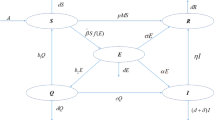Abstract
A model for assessing the effect of periodic fluctuations on the transmission dynamics of a communicable disease, subject to quarantine (of asymptomatic cases) and isolation (of individuals with clinical symptoms of the disease), is considered. The model, which is of a form of a non-autonomous system of non-linear differential equations, is analysed qualitatively and numerically. It is shown that the disease-free solution is globally-asymptotically stable whenever the associated basic reproduction ratio of the model is less than unity, and the disease persists in the population when the reproduction ratio exceeds unity. This study shows that adding periodicity to the autonomous quarantine/isolation model developed in Safi and Gumel (Discret Contin Dyn Syst Ser B 14:209–231, 2010) does not alter the threshold dynamics of the autonomous system with respect to the elimination or persistence of the disease in the population.







Similar content being viewed by others
Explore related subjects
Discover the latest articles and news from researchers in related subjects, suggested using machine learning.References
Bacaër N (2007) Approximation of the basic reproduction number \(\mathcal{R}_ 0\) for vector-borne diseases with a periodic vector population. Bull Math Biol 69:1067–1091
Bacaër N (2009) Periodic matrix population models: growth rate, basic reproduction number and entropy. Bull Math Biol 71:1781–1792
Bacaër N, Abdurahman X (2008) Resonance of the epidemic threshold in a periodic environment. J Math Biol 57:649–673
Bacaër N, Guernaoui S (2006) The epidemic threshold of vector-borne diseases with seasonality. J Math Biol 3:421–436
Bacaër N, Ouifki R (2007) Growth rate and basic reproduction number for population models with a simple periodic factor. Math Biosci 210:647–658
Bacaër N, Ait Dads E (2011) Genealogy with seasonality, the basic reproduction number, and the influenza pandemic. J Math Biol 65(5):741–762
Chowell G, Castillo-Chavez C, Fenimore PW, Kribs-Zaleta CM, Arriola L, Hyman JM (2004a) Model parameters and outbreak control for SARS. EID 10:1258–1263
Chowell G, Hengartner NW, Castillo-Chavez C, Fenimore PW, Hyman JM (2004b) The basic reproductive number of ebola and the effects of public health measures: the cases of Congo and Uganda. J Theor Biol 1:119–126
Cooke KL, Kaplan JL (1976) A periodicity threshold theorem for epidemics and population growth. Math Biosci 31:87–104
Cornelius CE III (1971) Seasonality of gonorrhea in the United States. HSMHA Health Report 86:157–160
Day T, Park A, Madras N, Gumel AB, Wu J (2006) When is quarantine a useful control strategy for emerging infectious diseases?. Am J Epidemiol 163:479–485
Diekmann O, Heesterbeek JAP (2000) Mathematical epidemiology of infectious diseases: model building, analysis and interpretation. Wiley, New York
Donnelly C et al (2003) Epidemiological determinants of spread of casual agnet of severe acute respiratory syndrome in Hong Kong. Lancet 361:1761–1766
Dowell SF (2001) Seasonal variation in host susceptibility and cycles of certain infectious diseases. Emerg Infect Dis 7:369–374
Earn DJ, Dushoff J, Levin SA (2002) Ecology and evolution of the flu. Trends Ecol Evol 17:334–340
Feng Z (2007) Final and peak epidemic sizes for SEIR models with quarantine and isolation. Math Biosci Eng 4(4):675–686
Feng Z, Xu D, Zhao H (2007) Epidemiological models with non-exponentially distributed disease stages and application to disease control. Bull Math Biol 69:1511–1536
Gumel AB et al (2004) Modelling strategies for controlling SARS outbreaks. Proc R Soc Ser B 271:2223–2232
Hethcote HW, Levin SA (1989) Periodicity in epidemiological models. In: Applied mathematical ecology. Springer, Berlin
Hethcote HW, Zhien M, Shengbing L (2002) Effects of quarantine in six endemic models for infectious diseases. Math Biosci 180:141–160
Hong Kong in Figures (2006 Edition) Census and Statistics Department, Hong Kong Special Administrative Region
Kincaid D, Cheney W (1991) Numerical analysis. Mathematics of scientific computing. Brooks/Cole Publishing Co., Pacific Grove
Leung G et al (2004) The epidemiology of severe acute respiratory syndrome in the 2003 Hong Kong epidemic: an analysis of all 1755 patients. Ann Intern Med 9:662–673
Lipsitch M et al (2003) Transmission dynamics and control of severe acute respiratory syndrome. Science 300:1966–1970
Liu L, Zhao X, Zhou Y (2009) A tuberculosis model with seasonality. Bull Math Biol 72:931–952
Lloyd-Smith JO, Galvani AP, Getz WM (2003) Curtailing transmission of severe acute respiratory syndrome within a community and its hospital. Proc R Soc Lond B 170:1979–1989
London W, Yorke JA (1973) Recurrent outbreaks of measles, chickenpox and mumps: I. Seasonal variation in contact rates. Am J Epidemiol 98:453–468
Lou Y, Zhao X-Q (2010a) The periodic Ross-Macdonald model with diffusion and advection. Appl Anal 89(7):1067–1089
Lou Y, Zhao X-Q (2010b) A climate-based malaria transmission model with structured vector population. SIAM J Appl Math 70(6):2023–2044
McLeod RG, Brewster JF, Gumel AB, Slonowsky DA (2006) Sensitivity and uncertainty analyses for a SARS model with time-varying inputs and outputs. Math Biosci Eng 3:527–544
Mubayi A, Kribs-Zaleta C, Martcheva M, Castillo-Chvez C (2010) A cost-based comparison of quarantine strategies for new emerging diseases. Math Biosci Engrg 7(3):687–717
Riley S et al (2003) Transmission dynamics of etiological agent of SARS in Hong Kong: the impact of public health interventions. Science 300:1961–1966
Safi MA, Gumel AB (2010) Global asymptotic dynamics of a model for quarantine and isolation.. Discret Contin Dyn Syst Ser B 14:209–231
Smith HL (1995) Monotone dynamical systems: an introduction to the theory of competitive and cooperative systems. Mathematical Surveys and Monographs. American Mathematical Society; Providence
Smith HL, Waltman P (1995) The theory of the chemostat. Cambridge University Press, Cambridge
Thieme HR (1992) Convergence result and a Poincaré-Bendixon trichotomy for asymptotical autonomous differential equations. J Math Biol 30:755–763
Wang W, Ruan S (2004) Simulating the SARS outbreak in Beijing with limited data. J Theor Biol 227:369–379
Wang W, Zhao X-Q (2008) Threshold dynamics for compartmental epidemic models in periodic environments. J Dyn Diff Equat 20:699–717
Webb GF, Blaser MJ, Zhu H, Ardal S, Wu J (2004) Critical role of nosocomial transmission in the Toronto SARS outbreak. Math Biosci Engrg 1:1–13
Zhang F, Zhao X-Q (2007) A periodic epidemic model in a patchy environment. J Math Anal Appl 325:496–516
Zhao X-Q (2003) Dynamical systems in population biology. Springer, New York
Acknowledgements
One of the authors (ABG) acknowledges, with thanks, the support in part of the Natural Science and Engineering Research Council (NSERC) and Mathematics of Information Technology and Complex Systems (MITACS) of Canada. MAS gratefully acknowledges the support of the University of Manitoba Graduate Fellowship. The authors are grateful to N. Bacaër, L. Liu and X.-Q. Zhao for helpful discussions on the computation of reproduction ratio for non-autonomous systems. The authors are very grateful to the anonymous reviewers for their very constructive comments.
Author information
Authors and Affiliations
Corresponding author
Appendix
Appendix
Verification of Assumptions A1–A7 in Wang and Zhao (2008). The purpose here is to check whether the system (4) (or, equivalently, (1)) satisfies Conditions A1–A7 in Wang and Zhao (2008). Since the system (1) is equivalent to (4), the former system will be used in this analysis (for mathematical convenience). Using the notation in Wang and Zhao (2008), system (1) can be re-written as:
where,
and,
Furthermore, let,
It is easy to see that \(\mathcal{V}=\mathcal{V}^--\mathcal{V}^+.\) The functions \(\mathcal{F},\mathcal{V}^+\) and \(\mathcal{V}^-\) satisfy the following:
-
(A1)
For each 1 ≤ i ≤ 6, \(\mathcal{F}_i(t,x),\;\;\mathcal{V}^+_{i}(t,x)\;\;\hbox{and}\;\;\mathcal{V}^-_{i}(t,x)\) are non-negative, continuous on \({\mathbb{R}\times \mathbb{R}^6_{+}}\) and continuously differential with respect to x (since each function denotes a direct non-negative transfer of individuals).
-
(A2)
By assumption (it should be noted that it is assumed that some of the model parameters are ω-periodic functions), there exists a real number ω > 0, such that \(\mathcal{F}_i(t,x),\;\;\mathcal{V}^+_{i}(t,x)\) \(\hbox{and}\;\;\mathcal{V}^-_{i}(t,x)\) are ω-periodic in t.
-
(A3)
If x i = 0, then \(\mathcal{V}^-_{i}=0\) for i = 2, 3, 4, 5.
-
(A4)
\(\mathcal{F}_{i}=0\) for i = 1, 6.
-
(A5)
Define \(X_s=\{ x\ge0:\; x_i=0\; \hbox {for} \;i=2,3,4,5\}.\) It is clear that if x ∈ X s , then \(\mathcal{F}_{i}=\mathcal{V}_i^{+}=0\) for i = 2, 3, 4, 5. System (1) has a disease-free solution, given by x * = (\({\Uppi}/{\mu}\), 0, 0, 0, 0, 0). Define a 2 × 2 matrix
$$ M(t)=\left(\frac{\partial f_i(t,x^*)}{\partial x_j}\right)_{i,j=1,6}. $$It follows from (9), and the definitions of the matrices \({\mathcal{F}}\) and \({\mathcal{V}},\) that
$$ M(t)=\left[\begin{array}{ll} -\mu & \psi \\ 0 & -(\mu+\psi)\\ \end{array}\right]. $$ -
(A6)
Since M(t) is a diagonalizable matrix with negative eigenvalues, then
$$ \rho(\Upphi_M(\omega))<1. $$ -
(A7)
Similarly,−\({\mathcal{V}}\)(t) is a diagonalizable matrix with negative eigenvalues. Hence,
$$ \rho(\Upphi_{-V}(\omega))<1.$$Thus, the system (1) , or (equivalently) (4), satisfies Conditions A1–A7 in Wang and Zhao (2008).
Rights and permissions
About this article
Cite this article
Safi, M.A., Imran, M. & Gumel, A.B. Threshold dynamics of a non-autonomous SEIRS model with quarantine and isolation. Theory Biosci. 131, 19–30 (2012). https://doi.org/10.1007/s12064-011-0148-6
Received:
Accepted:
Published:
Issue Date:
DOI: https://doi.org/10.1007/s12064-011-0148-6




